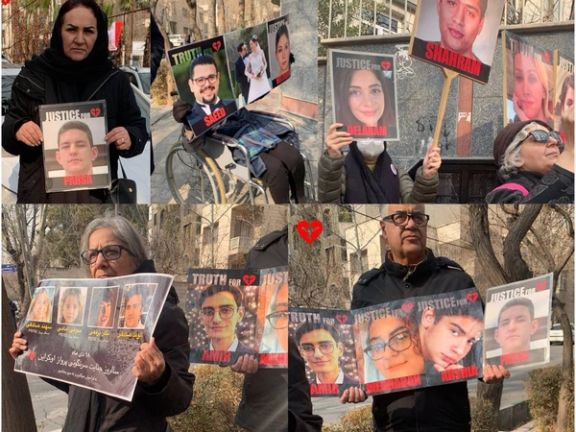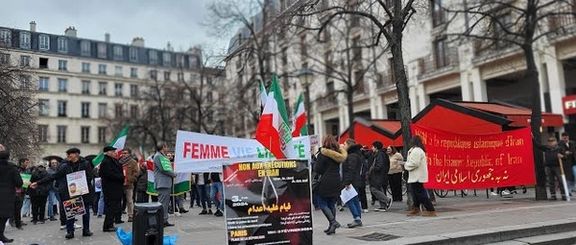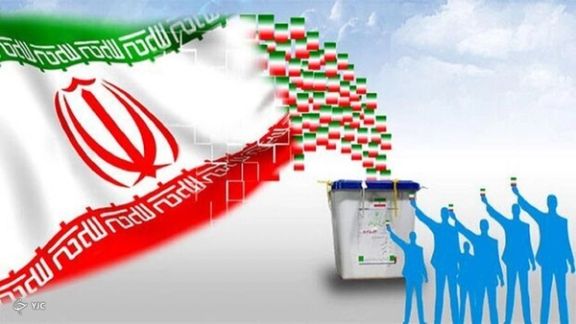Flight PS752 Victims Families Protest UN Official's Visit To Iran

Families of the victims of Flight PS752 protested the visit of the deputy United Nations human rights commissioner to Iran outside the UN's Tehran offices on Saturday.

Families of the victims of Flight PS752 protested the visit of the deputy United Nations human rights commissioner to Iran outside the UN's Tehran offices on Saturday.
Nada Al-Nashif is scheduled to arrive in Iran Sunday. During the three-day visit, she is due to address rights abuses in the Islamic Republic including spiking executions and deepening crackdowns on women's freedoms.
Protesters were confronted by law enforcement and security forces who quickly dispersed the crowd who lost families in the downed Ukrainian airliner incident on January 8, 2020. Iran's Revolutionary Guards (IRGC) shot down the plane shortly after it took off near Tehran's Imam Khomeini International Airport, resulting in the deaths of all 176 passengers and crew on board.
On Tuesday, families of Flight PS752 victims issued a statement addressing Nashif's visit. They emphasized the ongoing struggle against compulsory hijab laws and urged the UN official to meet with families of executed individuals and those impacted by recent protests in Iran.
In April, the Tehran military court sentenced the operator of the system, responsible for firing the missiles at the plane, to 13 years in prison and ordered him to pay compensation. Among the military personnel accused, none of the high-ranking military or government officials of the Islamic Republic are named.

The Iranian diaspora led demonstrations in the world's capital cities this weekend in a bid to protest the killing spree in Iran which is executing dissidents at record rates.
Protests were held in cities including Berlin, Stockholm, Vienna, and Copenhagen with others slated to take place in Amsterdam, Bern, Paris, Dublin, Cologne, London and others.
It follows growing calls globally to halt the executions. According to reports from HRANA, a human rights organization, the year 2023 witnessed the execution of at least 791 individuals in Iran, including 25 women and two juveniles—a staggering increase of over 33% compared to the preceding year.
The intensification of executions in Iran has spurred widespread global outrage, precipitating numerous protests in various corners of the world.
In its latest monthly assessment of the human rights landscape in Iran, HRANA documented that at least 90 people faced execution in December alone, underscoring the urgency of the international community's response to the escalating human rights violations within the country.
A panel of United Nations experts claim the number is even higher, announcing that at least 834 people were executed in Iran in 2023, including eight associated with the nationwide protests.
This year alone, dozens more have been executed as the crackdown on dissent deepens. At least 28 people are known to have been executed in just 10 days during January.
Statistics from the Iran Human Rights Organization reveal that since the beginning of 2024, at least 71 people have been executed in prisons across Iran. Of those, 28 were killed between January 21 and 31 alone.

Iran’s Revolutionary Guard had no presence in the military bases bombed by the United States, an IRGC general and a member of the Iranian parliament reiterated on Sunday.
Esmail Kowsari, who is of many IRGC senior officers in the hardliner faction in the parliament, reiterated that if there were any Iranian bases among the targets hit by the US in Iraq and Syria, Tehran would have retaliated. He also dismissed any role in the drone attack in Jordan on January 28 that killed three US soldiers and precipitated current tensions.
In the meantime, the United States and Britain launched strikes against 36 Houthi targets in Yemen on Saturday, in the second day of major US operations against Iran-linked groups. The strikes hit buried weapons storage facilities, missile systems, launchers and other capabilities the Houthis have used to attack Red Sea shipping, the Pentagon said, adding it targeted 13 locations across the country.
US officials had warned during the week that they were planning a string of attacks on Iran-affiliated targets in the region, and that the retaliatory operation would not be limited to one massive attack.

The action against the Houthis seems to have proven that threat. "This collective action sends a clear message to the Houthis that they will continue to bear further consequences if they do not end their illegal attacks on international shipping and naval vessels," US Defense Secretary Lloyd Austin said.
Iran seeing the writing on the wall tries to disassociate itself from the US strikes on its proxies. Kowsari, when asked if Iran would retaliate, said, "These attacks have no connection to Iran at all. But if the slightest action threatens our resources or interests by the United States, we will undoubtedly and certainly respond with a crushing blow that they will regret."
It is noteworthy that the first wave of retaliatory strikes in Iraq and Syria took place five days after the attack on the US base in Jordan, leading to criticism that IRGC personnel and senior proxy leaders had ample time to vacate military bases and potential target areas.
Attacks by Iran-backed armed groups started in mid-October after the Gaza war began and so far more than 160 such strikes on US forces in Iraq and Syria have taken place using drones and rockets. The US has retaliated several times against militia targets, but critics say without inflicting pain on the Iranian regime, which is the main sponsor of these groups, nothing will change. Tehran is ready to sacrifice Arab and Afghan fighters it employs, so any retaliation should be aimed at deterring Iran’s rulers.
Official Iranian statements and media coverage of US airstrikes on Saturday indicated that the concerns about a serious retaliation have dissipated and Tehran can move on with pursuing its regional policies.
By Sunday, Iran’s battered currency continued to rise and regained half of the losses it had sustained since early January, once the US strikes appeared to be limited to militia targets, and not directly aimed at any Iranian assets.
However, any increase in tensions with the United States could lead to further currency losses less than four weeks from parliamentary elections, already marred by voter apathy.

Iran’s recently stated plan to build four more nuclear power reactors has raised questions about its feasibility as the country wrestles with economic crisis and isolation.
According to early estimates, work has started in the southern region with a five-thousand-megawatt total capacity in mind. With 4,000 employment prospects and an estimated $20 billion cost, the planned nine-year schedule raises questions under current economic circumstances.
The difficulties Iran has faced in building new power plants in the last ten years raise doubts about whether the 25,000 megawatts of new electricity that the previous national development plan sought to bring about can be achieved.
The Iranian government pledged to raise the percentage of renewable and clean energy power plants to a minimum of five percent in line with the sixth development plan (2017–2021). However, the share of nuclear power is currently one percent, which means that the program's goals have been significantly missed.
The Research Center of the Iranian Parliament emphasizes that over 80 percent of the nation's energy is thermally produced, heavily reliant on natural gas, necessitating a diversification of the energy generation portfolio.
The only nuclear power plant in the country is a 1,000 megawatt facility that started up in 2011 with help from Russia. A 300 megawatt plant is reportedly under construction in Khuzestan.

Building times for nuclear power plants vary greatly due to factors like supply chain maturity, design revisions, and project management efficiency, but Iran faces a severe electricity shortage now. Consumption peaked at over 72,000 megawatts in 2023, surpassing the actual production capacity of power plants, capped at 60,000 megawatts during the warm season.
Iran is facing several obstacles in its efforts to build further nuclear power reactors, including financial and technological constraints, geopolitical and political instability, and international sanctions. The interplay of political and economic dynamics, together with worries about public opinion, safety, and international compliance, complicate Iran's nuclear energy development scenario. Moreover, Mohammad Eslami, the head of Iran’s nuclear energy said last week that Tehran is planning to build the new reactors relying on domestic financing and knowhow.
One interesting finding is that Iran seems to value nuclear energy security more than its overall needs for energy production. The strategic emphasis on deterrent and national security capabilities highlights a departure from the traditional objective of increasing nuclear power generation for energy purposes. Iran's attitude to international engagement, technical collaborations, and safety considerations in the nuclear realm may be greatly impacted by this strategic direction.
With its protracted delays and non-operational issues, Iran's first nuclear power plant—built with Russian assistance—remains insufficient to the country's energy security.
Iran's nuclear efforts are made more difficult by the geopolitical environment, namely by its confrontational foreign policy and various sanctions.
The question of whether these initiatives are feasible arises from the effect of sanctions on international collaboration and technical development. Iran must perform a sophisticated diplomatic dance to strike a balance between its desire for energy security and international relations as well as sanctions.
Examining Iran's foreign policy, one can see that the country is committed to scientific progress even in the face of external challenges, as seen by its tenacity in pursuing its nuclear program despite sanctions. Careful navigation is necessary to resolve the delicate dance between energy demands, geopolitical concerns, and the difficulties presented by international sanctions. Iran's prospects for the energy sector both at home and abroad will depend on how well it can surmount these challenges.

Amidst restrictions barring many Iranians and artists abroad from entering Iran, an American adult film actress has ignited controversy by sharing photos of her journey to Iran.
Whitney Wright published her photos including visits to sites like the former American embassy in Tehran.
Wright, known for her support of Palestine, posted images with captions expressing her curiosity about Iran. The controversy began when she shared a story of herself at Tehran's Golestan Palace, fully covered with Iran's mandatory hijab. Wright had previously solicited recommendations from her followers for Tehran's best foods and attractions.
Her Instagram page also features photos from her recent trips to Lebanon and Egypt. However, Wright's presence in Iran has sparked backlash from social media users, questioning the ease of her entry considering Iran's strict principles for women's morality and chastity.
Famous actress Setraeh Pesyani voiced her opposition, criticizing authorities for permitting Wright's visit while penalizing citizens for defying compulsory hijab. Pesyani took to Instagram, stating, "You punish the people of this land for hijab defiance, yet you allow a porn star to visit Iran for sightseeing? What's happening here?"
Earlier in January, Roya Heshmati, an Iranian woman, was subjected to 74 lashes for violating the Islamic Republic's mandatory hijab law, while another woman who refused to wear the hijab received a two-year prison sentence.
The Iranian regime, surprised by women's unwavering resistance of the compulsory hijab law, has been employing various tactics to dissuade them from removing their hijabs in public, albeit with very little success.

Low social media interest in the March 1 Iranian elections, along with recent polling data, confirm the prevailing sentiment of significant voter apathy among a disillusioned electorate.
A recent poll conducted by an unnamed government agency, presumably the intelligence or interior ministry, which was briefly mentioned by the semi-official Iranian Students News Agency (ISNA) found that turnout would be around 30 percent at the national level and less than 15 percent in the capital Tehran, the lowest-ever in the history of the Islamic Republic.
Information from the poll has been disseminated across various news outlets, but due to concerns about the potential for an extremely low voter turnout, authorities have resorted to censorship to prevent the exacerbation of an already critical situation.
On Tuesday, Khabar Online, a news website associated with former moderate conservative parliament speaker Ali Larijani, disclosed that they had received phone calls from unidentified individuals instructing them to remove the article covering the poll results from their website. They were informed that publishing any polls related to elections was deemed illegal.

The government's ineffectiveness, rampant corruption within state entities, and the dire economic conditions that have resulted in a significant decline in the living standards of working- and middle-class Iranians are some of the factors contributing to the electorate's decision to abstain from voting in both parliamentary and Assembly of Experts elections. Additionally, the harsh suppression of protests, such as the Woman, Life, Freedom protests in 2022-23, as well as earlier demonstrations in 2019 and 2017, along with the continuous erosion of social and political freedoms, have fueled a lack of trust in the system.
“I won’t vote. Anyone who votes will be a partner in the killing of the youth of the country”, “I will not vote for the sake of the Iranian girls who were blinded by the child-killing dictator”, “I will not vote, for the sake of my country and for people who want happiness,” people say in their tweets.
Many, including former regime insiders from various factions, such as reformists, supporters of former President Mahmoud Ahmadinejad, and moderate conservatives, argue that the extensive vetting of candidates by the Guardian Council in favor of hardliners has left them with no viable options to vote for.
“I have participated in all the elections so far. I really want to vote, but no candidate whose ideas are close to mine has been approved. How can I really vote? I can’t participate in the elections in these circumstances,” another tweet said.
Hardliners who dominate the current parliament had promised to fight poverty, corruption, discrimination, and inefficiency in government bodies but after four years the situation has only worsened.
“What you call ‘elections’ and consider participating in it a religious obligation is closer to ‘pledging allegiance’ to those in power both in form and meaning,” Farhad Badragheh, a member of Iran's Bar Association tweeted.
Regime supporters almost invariably say they will vote because Supreme Leader Ali Khamenei says they must. In June 2009, just days before the controversial presidential elections, Khamenei emphasized that people would not vote if they lacked hope in the country's future, did not trust the system, or did not feel free. He remarked, "When there is no trust, participation will be low. When participation is low, the legitimacy of the system will be affected."
“[I vote] because the future of my country is important to me, because my leader emphasizes on participating in the elections, and because anyone with common sense agrees with participating in the elections,” a regime loyalist said in his tweet with the hashtag #Iwillvote.
Following Khamenei’s lead, other state officials also insist that voting is a religious duty and claim that it is the enemies of the Islamic Republic who are trying to disillusion people.
The Friday Imam of Esfahan, Yousef Tabatabaei Nejad, said last week that those who do not vote are not Muslims and by not voting in these elections they are casting their ballots for the enemies of the regime.